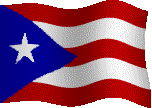STARS AND STRIPES
Dec 9, 1950

A PATROL OF "C" COMPANY, 65TH Infantry Regiment
returns to camp with enemy guerrillas
captured by the Puerto Ricans on outskirts of Yong
Hung.
 .News from the Korean War
.News from the Korean War 
STARS AND STRIPES
Dec 9, 1950

A PATROL OF "C" COMPANY, 65TH Infantry Regiment
returns to camp with enemy guerrillas
captured by the Puerto Ricans on outskirts of Yong
Hung.
One United States
dependency, little heard about from a publicity standpoint, is the
largest and most
vastly populated of all-Puerto Rico. But things started happening a
couple
of weeks ago that changed all that. First, Communist groups in the
capital
city of San Juan, led an uprising
against the duly elected Government. Then to show
they meant bussiness in their hostility toward the U.S. , this same
group directed sympathizers in America to assassinate President Truman.
The plot failed as
did their revolt.
These were all headline items
that
brought the West Indian island into focus. But the Puerto Ricans did
something
else previous to this same hectic time that didn't receive much
publicity.
The 65th Infantry Regiment, U.S. Army, made up largely of native Puerto
Ricans, landed in Korea to join forces with other UN troops. This
well-trained regiment is not new to the Army, however, and their unit
history indicates that their presence in the snow covered hills of
North Korea sounds another ominous note
for Communist aggressors.
Organized shortly after the
annexation of Puerto Rico following our war with
Spain in 1899, the 65th Infantry Regiment was first
known as the Puerto Rico Battalion of Volunteers Infantry. Following
several name changes and enlargements, including a battalion of mounted
troops, the regiment finally became a part of the Regular Army by an
Act of Congress on June 16, 1908 and was again renamed, the Puerto Rico
Regiment of Infantry, USA. The first official act after becoming a
member of the regular establishment was an inspection by the then
Eastern Department commander, Gen. Frederiek - D.
Grant, who afterward addressed the assembled troops. He stated, "This
is one
of the best regiments I have ever seen and there are few as good and
none
better under my command." Of this the 65th has remained proud and
endeavored to maintain the same standard of efficiency up to the
present date.
The regiment was brought up to full
battle strength in May of 1917 and ordered to the Panama Canal, where
it remained during the first World War, protecting that vital
installation. June 4,
1920, found the soldiers back home on their Caribbean island under
their
present name- 65th Infantry Regiment. They remained at their home
station
during the interim of great wars and it wasn't until the early part of
1943,
that they again took up security positions in Panama. From Pearl Harbor
until that time, they patroled every inch of their homeland in
anticipation of an
expected invasion.
While in the Canal Zone,
intensive jungle training was given to the troops when they could be
spared from the posts. Although they never has occacion to become
engaged in jungle fighting, they were nonetheless prepared.
Later that year the 65th
left the Zone and was shuttled to Fort Eustis, Va. where the men took
advanced Infantry training, and then sailled for North Africa. After
landing at Port Aux Poules, more training followed, this time in
amphibious tactics. Then on to France and Marseille. Their first
commitment to action was in the Maritme Alp region at Peira Cava This
short campaign resulted in 47 battle casualties. Then came patrol duty
and security missions in the Kaiserlantern-Manheim
sector of Germany . This was March, 1945. V-E Day found the fighting
Puerto
Ricans deep in the heart of Germany and in looking back over their
route
of advance they had won battle participation credits at Naples Foggia,
Rome-Arno,
Central Europe, and Rhineland campaigns.
While alerted for further action in the
Pacific
War, the signing of the Japanese surrender caught up with them and they
were
returned home to San Juan in November, !945.
In the
last five years the 65th Infantry has been anything but asleep. It has
trained extensively, participating in war games and joining in frequent
maneuvers.
A Maltese cross
predominates
the coat of arms of the 65th. The significance
of this ancient Christian symbol dates from early
Puerto Rican history, when at the time of the conquest of the island by
the Spanish in the 15th century the city of San Juan was named for the
military order of St. John of Jerusalem. This order was later renamed
the Knights of Malta, their dress being a black robe with a Maltese
Cross.
The regimental crest of a wreath
of colors with a rampant lion, was taken from the coat of arms of Ponce
de Leon, the island's first Spanish governor.
The UN forces in Korea will
find the men and officers of the 65th a ready and willing ally. They
carry with them a tradition and they aim to uphold it. Puerto-Ricans
are brawny fighters and they appreciate their stake in preserving the
freedom of a democratic world.

FIGHTING
PUERTO RICANS flush out hidden Korean Reds somewhere in Korea.
These men found two, added them to the regiment's PW
bag.